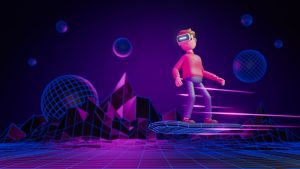The Metaverse is a virtual world accessed through the internet and combines elements of virtual reality, augmented reality, and the internet. It is a digital space where people can interact with each other and digital content in various ways, such as buying and selling virtual property, creating and selling digital art or other content, or playing games.
The Metaverse has become increasingly popular and is attracting attention from significant companies. As a result, it could be a focus of future investment, although investors’ opinions on its potential success may vary. Overall, the Metaverse is rapidly growing and evolving. So let’s dive into the top three metaverse trends to watch out for in 2023.
Augmented reality (AR) and virtual reality (VR)
Augmented reality (AR) and virtual reality (VR) allow users to immerse themselves in digital environments fully. AR overlays digital elements on top of the natural world, allowing players to simultaneously see and interact with both.
AR games often incorporate the player’s surroundings into the gameplay, such as Pokemon Go. Conversely, VR immerses players in a virtual world and blocks the real world. The VR experience relies on VR headsets, which often use motion tracking to allow players to move and interact with the virtual world physically.
AR and VR have significantly impacted gaming and are likely to continue to shape and evolve the industry as the market for these technologies grows.
Metaverse Events
Metaverse events are virtual events that take place within a virtual world, such as online concerts or trade shows. These events have the potential to generate significant revenue, with the global market for video game software and hardware expected to reach $400 billion by 2024 and additional opportunities coming from live entertainment and social media.
The popularity and prevalence of metaverse events will likely increase as technology and infrastructure for virtual events improves. For example, in the future, concerts and other live events may increasingly occur within virtual worlds rather than physical locations.
The Complexity of Virtual Representations
The complexity of metaverse avatars refers to the level of detail and realism in the avatar. Metaverse avatars are digital representations of users in virtual worlds or online environments.
They can range from simple 2D models to highly advanced, photorealistic avatars. Some companies, like Meta, are known for their advanced avatars, while others, like Microsoft, use artificial intelligence (AI) to create more responsive and realistic avatars.
In general, the complexity of metaverse avatars is increasing over time as technology and resources improve, and more companies enter the market. However, it is also possible to create simple avatars using apps like Zepeto and OSUVOX, which make it easy for users to create and export avatars into various metaverse implementations.
Disclaimer: NFTs and Cryptocurrencies are highly volatile, conduct your own research before making any investment decisions. Some of the posts on this website are guest posts or paid posts that are not written by our authors (namely Business Voices content) and the views expressed in these types of posts do not reflect the views of this website. Please read our full disclaimer here.




